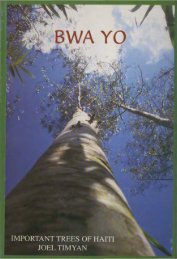Biodiversité - Société Audubon Haiti
Biodiversité - Société Audubon Haiti
Biodiversité - Société Audubon Haiti
You also want an ePaper? Increase the reach of your titles
YUMPU automatically turns print PDFs into web optimized ePapers that Google loves.
48<br />
tangara quatre yeux<br />
(PhaeNicoPhilus PoliocePhalus)<br />
Sédentaire reproducteur – Endémique menacé<br />
Cette espèce est présente sur les trois sites d’étude, mais<br />
moins abondante qu’en<br />
2004. A Rak Bwa, seulement<br />
4 individus ont été capturés<br />
(10 en 2004), dont l’un est<br />
un retour. A Formon où l’habitat<br />
ne se différencie guère<br />
du site étudié (Plaine Bœuf)<br />
en 2004 (Rimmer et al. 2005),<br />
on en a capturé 4 (7 à Plaine<br />
Boeuf en 2004) et détecté 8<br />
individus (14 à Plaine Bœuf).<br />
A Pic Macaya, on en a observé<br />
4. C’est la seule espèce<br />
d’oiseau endémique à Hispaniola<br />
dont la distribution se<br />
confine en Haïti (Keith et al.<br />
2003, Latta et al. 2006). Peu<br />
d’informations fiables sont<br />
disponibles en provenance<br />
de la Sierra de Bahoruco en<br />
République Dominicaine,<br />
et aucune documentation<br />
récente non plus concernant<br />
le Massif de la Selle. Le<br />
massif de la Hotte est indiscutablement l’habitat privilégié<br />
de cette espèce. Tangara quatre-yeux y est donc généralement<br />
et parait être localement commun dans tous les habitats<br />
forestiers de la Réserve de la Biosphère de Macaya,<br />
comme l’ont noté Wood et al (1992) dans les années 80.<br />
tangara d’haïtI<br />
(calyPtoPhilus tertius)<br />
Sédentaire reproducteur<br />
– Endémique en danger critique d’extinction<br />
Cette espèce a été rencontrée dans les trois sites, mais en<br />
nombre relativement élevé dans la forêt dense latifoliée<br />
de la crête du Pic Formon et dans les parcelles latifoliées<br />
du Pic Macaya (Tableau 1). Woods et Ottenwalder (1983,<br />
1992) l’ont aussi trouvée à toutes les altitudes et inventoriée<br />
dans les années 80, mais ils l’ont classée parmi les oiseaux<br />
les plus en danger d’Haïti. Birdlife International désigne<br />
le Tangara d’Haïti comme un oiseau plutôt complexe et<br />
en tous points «vulnérable» (Stattersfield et al. 1998). Les<br />
observations indiquent que l’espèce est localement commune,<br />
surtout dans les forêts d’altitudes très hautes, et<br />
peut-être plus en sécurité à Macaya que les autres espèces<br />
restreintes aux forêts humides latifoliées sur calcaire.<br />
gray-croWned PalM-tanager<br />
(PhaenIcoPhIlus PolIocePhalus)<br />
This species occurred at all three study sites, although it<br />
appeared to be less abundant than in 2004. At Rak Bwa,<br />
we mist-netted only 4 individuals (10 in 2004), one of which<br />
was a return. At Formon, where the habitat resembled that<br />
at our 2004 Plaine Boeuf study<br />
site (Rimmer et al. 2005), we captured<br />
4 Gray-crowned Palm-Tanagers<br />
(7 at Plaine Boeuf in 2004)<br />
and detected 8 individuals (14 at<br />
Plaine Boeuf). On Pic Macaya,<br />
we observed 4 individuals. This<br />
is the only Hispaniolan endemic<br />
bird species with its range effectively<br />
confined to <strong>Haiti</strong> (Keith et<br />
al. 2003, Latta et al. 2006); few<br />
reliable records have been obtained<br />
from Sierra de Bahoruco of<br />
the Dominican Republic, and no<br />
recent documentation has been<br />
obtained from Massif de la Selle.<br />
Massif de la Hotte is unquestionably<br />
the species’ stronghold.<br />
Gray-crowned Palm-Tanagers are<br />
habitat generalists and appear to<br />
be locally common in all forested<br />
habitats of Macaya Biosphere<br />
Reserve, as noted by Woods et al.<br />
(1992) in the 1980s.<br />
Western chat-tanager<br />
(calyPtoPhIlus tertIus)<br />
We encountered this species at all three sites, but its relative<br />
abundance was higher in the dense broadleaf forest on the<br />
Pic Formon ridgeline and in broadleaf patches on Pic Macaya<br />
(Table 1). Woods and Ottenwalder (1983, 1992) also<br />
found Western Chat-Tanagers at all elevations sampled in<br />
the 1980s, but they considered it among the most endangered<br />
birds in <strong>Haiti</strong>. Birdlife International designates the Calyptophilus<br />
complex as globally “Vulnerable” (Stattersfield<br />
et al. 1998). Our observations indicate that the species is<br />
locally common, especially in higher elevation forests, and<br />
we believe its status in Macaya may be more secure than<br />
those of species that are more restricted to the broadleaf<br />
karst forests.



